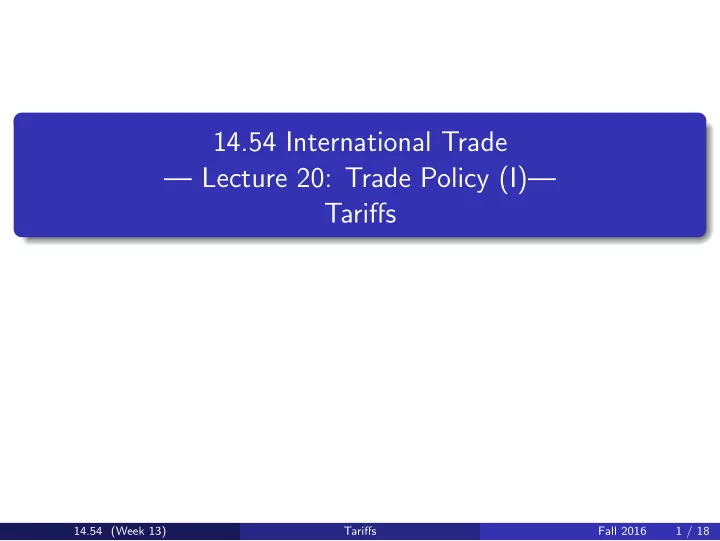

14.54 International Trade — Lecture 20: Trade Policy (I)— Tariffs 14.54 Week 13 Fall 2016 14.54 (Week 13) Tariffs Fall 2016 1 / 18
Today’s Plan Tariffs, Import Demand, and Export Supply 1 Welfare Consequences of Tariffs 2 Graphs on slides 5-17 are courtesy of Marc Melitz. Used with permission. 14.54 (Week 13) Tariffs Fall 2016 2 / 18
Trade Policy Tools Government can use many tools to affect the equilibrium prices of traded goods and the quantities of the traded good produced and consumed Most cases of such interventions involve the restriction of imports, but governments also tax or subsidize exports The tools of import restriction are: Tariffs: specific or ad-valorem 1 Quotas or ‘voluntary export restrictions’ 2 Regulations: testing, customs, labeling, domestic content requirement 3 14.54 (Week 13) Tariffs Fall 2016 3 / 18
Modeling the Effects of Trade Policy In the course so far, we have modeled trade in general equilibrium: Trade affects all sectors in the economy Trade policy is most often directed at very specific sectors In these cases, it is reasonable to model the effects of trade in partial equilibrium: We assume that the trade policy will have minimal repercussions on economy-wide factor markets and will not induce income effects in consumption Thus, the sector in question must be small relative to the rest of the economy We can then analyze the effects of the trade policy on a particular sector independently from the rest of the economy This involves the standard tools of supply and demand analysis ... which determine the equilibrium prices and outputs for that sector 14.54 (Week 13) Tariffs Fall 2016 4 / 18
Import Demand and Export Supply 14.54 (Week 13) Tariffs Fall 2016 5 / 18
Determination of Equilibrium Trade Price Note how p W must be in between the 2 autarky prices (which still determine the pattern of comparative advantage) 14.54 (Week 13) Tariffs Fall 2016 6 / 18
The Effects of Relative Country Size The relative size of the countries will affect the slopes of the import demand and/or export supply curves: As the relative size difference increases further, we obtain (in the limit) the case of the ‘small’ open economy 14.54 (Week 13) Tariffs Fall 2016 7 / 18
Small Open Economies For these economies, we can model domestic supply and demand, along with the exogenous world price 14.54 (Week 13) Tariffs Fall 2016 8 / 18
The Effects of an Import Tariff for a Large Country A tariff is just a tax on imports (a specific tariff t is assumed): The tariff will raise the price of a good above its free trade level ( p W ) ... and reduce imports It also reduces the world trade price: this is the terms of trade effect ... so the price rises by less than the full amount of the tariff 14.54 (Week 13) Tariffs Fall 2016 9 / 18
The Effects of an Import Tariff for a Small Country The tariff does not affect the world trade price The price will rise by the full amount of the tariff 14.54 (Week 13) Tariffs Fall 2016 10 / 18
Review of Welfare Analysis in Partial Equilibrium Recall that for competitive markets, the demand curve represents the marginal benefit of consumption and the supply curve represents the marginal cost of production Consumer surplus represents the net benefit from consumption: CS = TB − P . Q Producer surplus represents the variable profits from production (without accounting for the fixed costs): PS = P . Q − TVC 14.54 (Week 13) Tariffs Fall 2016 11 / 18
Welfare Under Free Trade for an Importing Country 14.54 (Week 13) Tariffs Fall 2016 12 / 18
Welfare Effects of a Tariff for a Large Importer The tariff will: Reduce consumer surplus (area 1+2+3+4) 1 Increase producer surplus (area 1) 2 Generate tariff revenue (area 3+5) 3 Resulting in a net welfare gain or loss (area 5-2-4) 4 14.54 (Week 13) Tariffs Fall 2016 13 / 18
Welfare Effects of a Tariff for a Large Importer (Cont.) Note that the division of the tariff revenue between areas 3 and 5 depends on the terms of trade effect of the tariff For a small country, there are no terms of trade effect, and area 5 disappears That area captures a welfare gain from the tariff induced by the improvement in the terms of trade ... and the tariff then can only induce welfare losses (area 2+4) 14.54 (Week 13) Tariffs Fall 2016 14 / 18
Tariff Distortions and Welfare Area 2 always represents a loss to total welfare. What is generating this loss? Area 2 represents the domestic production distortion from the tariff Each additional unit of output is produced at a marginal cost above its opportunity cost (the world price p W ) 14.54 (Week 13) Tariffs Fall 2016 15 / 18
Tariff Distortions and Welfare (Cont.) Area 4 always represents a loss to total welfare. What is generating this loss? Area 4 represents the domestic consumption distortion from the tariff The marginal benefit of the foregone units consumption are above their opportunity cost (the world price p W ) 14.54 (Week 13) Tariffs Fall 2016 16 / 18
Tariffs and Welfare For a large economy, what are the net changes in welfare induced by a tariff? i.e. the relative importance of the gain from the terms of trade improvement (lower p W ) and the production/consumption distortions For small tariffs, the gain from the terms of trade improvement dominates, but not for larger tariffs There is an ‘optimal’ tariff level t ∗ The more the foreign export supply to a country is inelastic, the higher the optimal tariff t ∗ 14.54 (Week 13) Tariffs Fall 2016 17 / 18
MIT OpenCourseWare https://ocw.mit.edu 14.54 International Trade Fall 2016 For information about citing these materials or our Terms of Use, visit: https://ocw.mit.edu/terms.
Recommend
More recommend